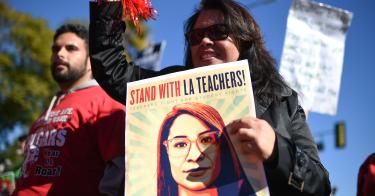“This wouldn’t happen at Hogwarts.” So read a protest sign displayed during the recent LA teacher strike. But no district official — or lawmaker or taxpayer — can wave a magic wand to make LAUSD’s crushing fiscal problems go away.
After more than a week of negotiating, LAUSD officials largely agreed to union demands, and teachers returned to work on Jan. 23. News media have called the settlement “historic,” but considering the promises for additional hires and new funding, the settlement sounds more like quick surrender.
The district agreed to hire more school counselors and nurses, reduce class sizes, and provide teachers with a 6 percent raise. Notably, the union did not achieve its goal of placing an official cap on charter schools, though a list of restrictions was added to the ways in which charter schools can expand.
Still, the district remains mired in a financial crisis. Calling it “insolvent” is no exaggeration. Over the last year, policymakers have discussed a state takeover to deal with the district’s pension shortfalls, escalating health care and special education expenses, and other woes.
Making promises to spend more in order to end the strike was the easy part. LAUSD superintendent Austin Beutner has admitted he still does not know how the district will pay for these spending increases.
Perhaps the only thing “historic” about the end of this strike is that history repeats itself — and will again without fiscally responsible changes in the union contract. As the LA School Report has documented, the problems that led to this work stoppage are eerily similar to those that led to the 1989 strike: mounting debt and union demands for more money.
If there is a difference this time, it would be that some 100,000 students were not made negotiating pawns. Instead, they continued to receive an education in charter schools operating in LA. Nearly one in five students in the district attends a charter school, and almost all remained open during the strike.
While the union is pressing to limit charters, surely parents are not. Last May, the state superintendent named an LA charter school a California Model Program, while another received recognition for its work with students with special needs. Seven of the top 10 highest-performing California high schools are charter schools.
Around the country, surveys indicate charter schools have significant waiting lists or that parents would send their child to a charter if one was available. And in school districts in other states facing teacher strikes, many — if not most — charter schools also remained open. When teachers went on strike in Washington state last fall, charters stayed open — as was the case last year in Arizona. The charter model — public schools usually governed by an independent board — provides families with a hopeful alternative.
So long as district administrators and state lawmakers resolve strikes by committing to higher spending without substantive policy changes that involve more parental choice and fiscal restraint, strikes will spread. Just this week, Denver teachers announced they are preparing to strike. Over the past six months, similar reports have surfaced in Oakland, California; Indiana; and Louisiana, to name a few.
And why wouldn’t they? Some policymakers seem to have no qualms about promising more spending and higher salaries, even when they don’t know where the money will come from.
In a revealing comment, LA teacher union president Alex Caputo-Pearl touched what may be the most substantive result of the strike. Like Superintendent Beutner, Caputo-Pearl acknowledged that just because the strike is over, his work is not done.
While Beutner and other officials now must go to taxpayers to find more spending, Caputo-Pearl has a different bottom line. “Like with any struggle, you gotta win some things, and then you gotta keep on building your power,” Caputo-Pearl said. This appears to be the union’s measure of success.
This piece originally appeared in Los Angeles Daily News





